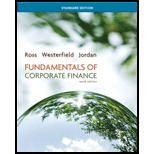
a)
To determine: The estimated operating cash flow (OCF) and
Introduction:
Net present value (NPV) refers to the discounted value of the future cash flows at present. In case, if the NPV is positive or greater than zero, then the company will accept the project or vice-versa. If there are two mutually exclusive projects, then the company has to select the project that has higher net present value.
a)
Answer to Problem 27QP
The estimated Operating cash flow is $1,219,100 and the NPV of the project is $691,152.56.
Explanation of Solution
Given information:
The annual fixed costs are $850,000, variable cost per unit is $185 per ton, number of quantity supplied is 25,000, marginal tax rate is 38%, initial investment on the equipment is $3,600,000, and life of the project is five years. The net initial working capital investment is $360,000 and the required
Formulae:
The formula to calculate the operating cash flow:
Where,
P refers to the price per unit of the project,
v refers to the variable cost per unit,
Q refers to the number of unit sold,
FC refers to the fixed costs.
The formula to calculate the NPV:
Where,
n refers to the number of years.
Compute the Operating cash flow (OCF):
Hence, the estimated Operating cash flow (OCF) is $1,219,100.
Compute the NPV:
Note: To determine the present value of annuity of $1 period for 5periodsat a discount rate of 13%, refer the PV of an annuity of $1 table. Then, find out the 13% discount rate and period of 5 years’ value from the table. Here, the value for the rate 13% and 5 years’ period value is 3.51723.
Hence, the NPV is $691,152.56.
b)
To determine: The worst-case scenario and best-case scenario of the project.
Introduction:
Scenario analysis is a process of analyzing the possible future events. This analysis helps to determine the effect of what-if questions towards the net present value estimates. At the time when the firm begins to look for an alternative, then they might be able to find the possible project, which would result in a positive net present value (NPV).
b)
Answer to Problem 27QP
Worst-case scenario:
The operating cash flow of the worst-case is $826,140.
The net present value (NPV) of the worst-case is −$1,264,095.08.
Best-case scenario:
The operating cash flow of the best-case is $1,612,060.
The net present value (NPV) of best-case scenario is $2,647,103.64.
Explanation of Solution
Given information:
The annual fixed costs are $850,000, variable cost per unit is $185 per ton, number of quantity supplied is 25,000, marginal tax rate is 38%, initial investment on the equipment is $3,600,000, and life of the project is five years. The net initial working capital investment is $360,000 and the required rate of return is 13%. The selling price is $280 and salvage value is $500,000.
The initial cost and salvage value of the projection are ±15%. The price estimate will be accurate within ±10% as per the marketing department. The estimate of net working capital is ±5%.
Formulae:
The formula to calculate the operating cash flow for best or worst-cases scenarios:
Where,
P refers to the price per unit of the project,
v refers to the variable cost per unit,
Q refers to the number of units sold,
FC refers to the fixed costs.
The formula to calculate the NPV of best or worst-cases:
Note: In the best-case scenario, both the price and sales indicate an increase in the value; whereas, the costs will indicate a decrease in the value. In the worst-case scenario, both the price and sales indicate a decrease but the costs will specify an increase in the value.
Compute the operating cash flow for worst-case scenario:
Note: The tax shield approach is used to determine the operating cash flow of worst-case scenario. In this problem, the price and quantity is decreased by 10%. As a result, both the price and quantity are multiplied by a 10% decrease. However, the variable and fixed costs will indicate an increase by 15 percent.
Hence, the operating cash flow of worst-case scenario is $826,140.
Compute the NPV of worst-casescenario:
Hence, the NPV of worst-case scenario is −$1,264,095.08.
Compute the operating cash flow for best-case scenario:
Hence, the operating cash flow of best-case scenario is $1,612,060.
Compute the NPV of best-casescenario:
Hence, the NPV of best-case scenario is $2,647,103.64. Both the worst scenarios indicate a negative NPV. Therefore, it will be difficult to proceed with the project.
Want to see more full solutions like this?
Chapter 11 Solutions
Fundamentals of Corporate Finance Standard Edition with Connect Plus
 Essentials Of InvestmentsFinanceISBN:9781260013924Author:Bodie, Zvi, Kane, Alex, MARCUS, Alan J.Publisher:Mcgraw-hill Education,
Essentials Of InvestmentsFinanceISBN:9781260013924Author:Bodie, Zvi, Kane, Alex, MARCUS, Alan J.Publisher:Mcgraw-hill Education,

 Foundations Of FinanceFinanceISBN:9780134897264Author:KEOWN, Arthur J., Martin, John D., PETTY, J. WilliamPublisher:Pearson,
Foundations Of FinanceFinanceISBN:9780134897264Author:KEOWN, Arthur J., Martin, John D., PETTY, J. WilliamPublisher:Pearson, Fundamentals of Financial Management (MindTap Cou...FinanceISBN:9781337395250Author:Eugene F. Brigham, Joel F. HoustonPublisher:Cengage Learning
Fundamentals of Financial Management (MindTap Cou...FinanceISBN:9781337395250Author:Eugene F. Brigham, Joel F. HoustonPublisher:Cengage Learning Corporate Finance (The Mcgraw-hill/Irwin Series i...FinanceISBN:9780077861759Author:Stephen A. Ross Franco Modigliani Professor of Financial Economics Professor, Randolph W Westerfield Robert R. Dockson Deans Chair in Bus. Admin., Jeffrey Jaffe, Bradford D Jordan ProfessorPublisher:McGraw-Hill Education
Corporate Finance (The Mcgraw-hill/Irwin Series i...FinanceISBN:9780077861759Author:Stephen A. Ross Franco Modigliani Professor of Financial Economics Professor, Randolph W Westerfield Robert R. Dockson Deans Chair in Bus. Admin., Jeffrey Jaffe, Bradford D Jordan ProfessorPublisher:McGraw-Hill Education





